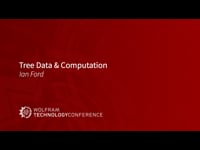1312 videos match your search.
 |
James Lane New Graphics features in Version 13 include MaterialShading, a new Light directive and the canonicalization of AxisObject. Graphics has significant improvements to software rasterization, Dashing, VertexTextureCoordinate specification and the ability to ... |
 |
Bernat Espigule This talk discusses New Learning Journeys, created exclusively for the History of Mathematics Project. Virtual exhibits and their navigation were entirely built using Wolfram Language, the Wolfram Knowledgebase and Wolfram ... |
 |
Gosia Konwerska, PhD, and Eduardo Serna Spatial point patterns are collections of randomly positioned events in space. Examples include trees in a forest, positions of stars, earthquakes, crime locations, animal sightings, etc. Spatial point data analysis, ... |
 |
Leonardo Roncetti Mathematica's parallel functions make it possible to produce video and plots of results after collecting various image processing data during transport and lifting engineering operations. The goal of the work ... |
 |
Jose Martin-Garcia |
 |
Rory Foulger, Fiona Law, Rohan Mehta and Joseph Stocke |
 |
Jason Harris Many everyday notations and structures in Mathematica now use TemplateBoxes in the front end, making it an important building block for developers. This presentation discusses multiple topics around this somewhat ... |
 |
Matthew Adams and John Pacey This talk details our efforts to bring the full power of Wolfram Language graphics to the Wolfram Cloud. We break down our next-generation graphics rendering system and give a sneak ... |
 |
Ian Ford Trees are fundamental data structures in mathematics and science, with standard examples including XML trees, file systems and Wolfram Language expressions. We present symbolic Tree objects, added in Version 12.3 of ... |
 |
David Park The GrassmannCalculus application, based on the work of Grassmann and Browne, is described. One example, the derivation of coordinate equations for lines and planes in n-dimensional space, is presented. This ... |
 |
Jose Martin-Garcia, Jeff Bryant and Truman Tapia |
 |
Connor Gray Wolfram Language paclets are the standard way to extend the Wolfram System with new functionality. In this presentation, you will learn how to create and share high-quality paclets. |
 |
Giulio Alessandrini Machine learning superfunctions like Predict and Classify have tried to bridge the gap between beginner and specialist Wolfram Language users by offering a fully automated yet customizable pipeline. Over time, ... |
 |
Robert Nachbar This talk describes the development of the idea of using combinators to model chemical structures and how to use Wolfram Language to get there. |
 |
Joseph Butner This talk discusses the possibilities of using Mathematica within checkpoint inhibitor immunotherapy, a clinical approach to cancer treatment, to more accurately predict treatment outcomes allowing for even more personalized treatment ... |
 |
Jesse Galef This talk highlights both existing and upcoming tools in Wolfram Language that can be used to gain insight into machine learning models. |
 |
Richard Carbone Wolfram Language provides the ability to work with a broad range of capabilities that apply to various areas of forensic analysis frameworks. This presentation shows brief examples of complete applications, ... |
 |
Carol Johnstone Though accelerators represent a $500B industry, development of advanced and ultra-compact accelerator applications has been stymied due to dated or difficult-to-use design tools with limited optimization algorithms. This presentation covers ... |
 |
Melvin Friedman, PhD Phys Presentation shows how to coordinate traffic signals on Telegraph Rd, (a two-way road, 10.4 miles in length, with 21 traffic signals) so that motorists traveling at the recommended speed make every traffic ... |
 |
Tuseeta Banerjee and Matteo Salvarezza In this talk, we review the current state of the ONNX importer and exporter in Wolfram Language and show how to use their options and properties. With the help of ... |